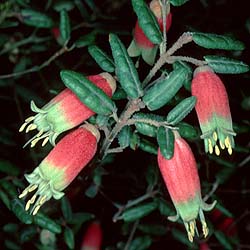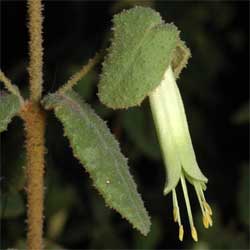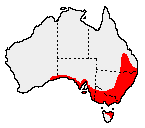Correa reflexa
 |
 |
Native Fuchsia (in Victoria)
Correa reflexa (Labill.) Vent.
Correa belongs to the family Rutaceae, along with the genera Boronia and Philotheca.
Correa reflexa is sometimes referred to as Native Fuchsia, a name it shares with Epacris longiflora. Its distribution ranges from southeast South Australia, through Victoria to eastern New South Wales and continues into south-east Queensland; it includes eastern Tasmania and Kangaroo Island off South Australia. The plant occurs in a variety of habitats from mountain forests to dry mallee-scrub which together with its geographical distribution indicates its degree of adaptability.
 Correa
reflexa has some twenty or so distinct forms many of which have been given
varietal names, the most notable being C. reflexa var. reflexa;
var. nummularia; var. cardinalis; and var. coriacea.
Correa
reflexa has some twenty or so distinct forms many of which have been given
varietal names, the most notable being C. reflexa var. reflexa;
var. nummularia; var. cardinalis; and var. coriacea.
It has naturally hybridised with C. alba, C. decurnbens, C. aemula and C. pulchella.
A variable species, Correa reflexa ranges from semi-prostrate to 1.2 m erect. Its habit is compact to open and it has heart-shaped to rounded or narrow, simple opposite leaves.
The leaves vary from rough and hairy to almost smooth-surfaced above and slightly furry beneath with flat or recurved margins.
Flowers are woolly-surfaced, tubular to bellshaped. The tips of the joined petals are turned back or reflexed, with eight slightly protruding stamens. These are usually pendulous with two or three together on short, slender terminal or axillary stalks. Flowers are yellow green to crimson red with yellow to green tips and stamens tipped with large yellow anthers.
Flowering time is chiefly between May and November, and intermittently throughout the year, and the plant grows well in practically any soil, in shade or full sun. To grow it at its best, a light sandy soil with good drainage and a position protected from wind, with broken or morning sunlight, is desirable. Groups of three to five offer added protection and enhance visual appeal.
A friable rich compost used as a mulch, or lightly forked into the soil around the plant's root zone, is beneficial. Otherwise, a complete fertilizer in moderate amounts in early autumn and spring, or a combination of the two, will give good results. Regular, deep watering, especially during the growing season, is essential for healthy growth and flowering.
Regular tip pruning, best done after the main flowering period in late spring, will encourage development of a well-branched, compact shrub and increase flower numbers the following season.
Soft tip cuttings taken in late summer and early autumn offer best results when propagating. These should be no more than 75 mm long with a clean, smooth basal-cut immediately below a leaf node. Rooting hormone may help the cutting establish root systems if misting and/or bottom heat is not available. Cuttings should be potted-on to individual containers as soon as they have developed from four to seven roots in the cutting mixture, liquid fertilizer, such as Aquasol, helps at this stage.
Because it is free from pests and diseases and offers a good return of flowers, Correa reflexa is an excellent species and well worth growing.
*RHS Colour Chart, 1966, Green form - corolla, yellow-green group 154D; corolla tips, yellow-green group 144B. Red form - corolla, varying between red group 51B and 46A; corolla tips, yellow-green group 145A.
Name meaning: Correa reflexaCorrea after Jos6 Francisco Correa de Serra (1750-1823), a Portuguese botanist who published several papers on the family Rutaceae; reflexa from the Latin word reflexus, meaning turned or bent backwards, referring to the bracts |
![An Australian Government Initiative [logo]](/images/austgovt_brown_90px.gif)

